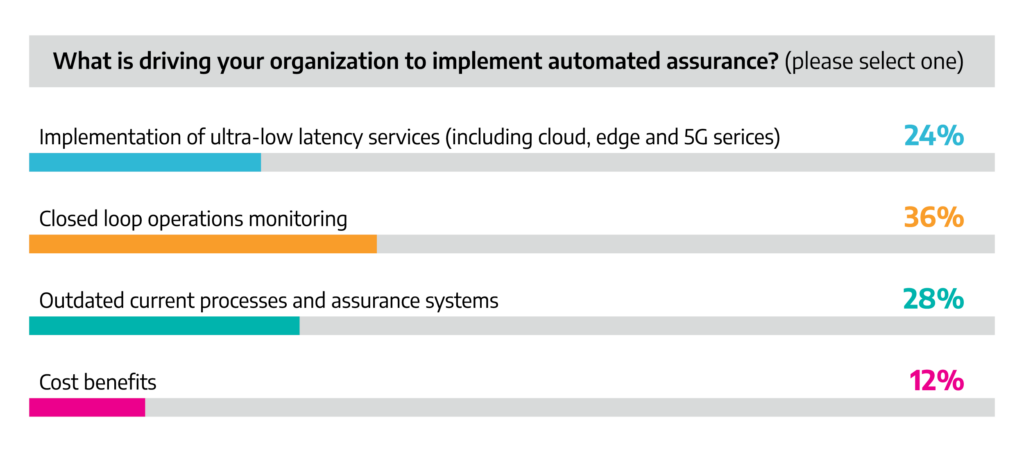Between 5G, the cloud, edge services, disaggregation and virtualization, running a network is quickly becoming more complex than ever. This complexity makes it tougher than ever to understand exactly what service quality each customer is experiencing.
No wonder so many communications service providers (CSPs) are doing a fundamental rethink of their service assurance strategy and capabilities. In fact, TM Forum’s Service Assurance in the 5G era research report finds increasing use of artificial intelligence (AI) in operations (AIOps). Service providers are bullish, however, about the long-term prospects for fully autonomous networks, with more than half believing their companies will deploy them within a decade.
For example, CSPs want the ability to find and fix problems at microsecond speeds — before customers start to notice. They also need that ability at unprecedented scale because thanks to the Internet of Things (IoT), a typical CSP now may have thousands of types of services with tens or hundreds of millions of simultaneous connections. Each of those services will have its own unique performance and quality of experience (QoE) requirements, such as jitter, latency and bandwidth.
To ensure that they’re providing consistently great customer experiences, service providers are gravitating toward closed-loop automation with tightly integrated network and service orchestration and assurance. This is the only way to get instant visibility into the network and service health and what’s happening with the user experience. It lets CSPs analyze and then act on real-time, KPI-level insights into network components and the customer applications and services running over them. Without those insights, service providers can’t understand the customer experience, which is key for meeting enterprise SLAs. It’s the telecom equivalent of flying blind.
“It’s clear that the shift to cloud- and edge-based services is really driving service providers to review their assurance strategies,” Jim Hodges, Heavy Reading Research Director for Cloud and Security, said in an April 28 webinar, “Making Automated Assurance a Reality, Accelerate Outcomes and Reduce Risk”, “Automated assurance is a key part of this because of all the opportunities.”
This importance came through in a Heavy Reading survey that Hodges discussed. Although many CSPs planning to deploy edge services agreed that automated service assurance is important, that perception skyrockets once they’ve deployed edge services (see Figure below). That’s when service providers experience the additional complexity first-hand and get a fuller appreciation of how automated active testing and performance insights provide the visibility they need.
Lessons Learned from Colt’s Service Assurance Journey
For service providers, one way to understand the business benefits and implementation options is to learn from peers that have already begun executing their next-gen service assurance strategies. One example is Colt Technology Services, which is now halfway through a three-year process of replacing all existing performance- and fault-monitoring systems.
“You get unparalleled visibility over your entire ecosystem,” Colt Vice President of Network Operations Shane Sura explained during the Light Reading webinar. “You get untapped data access. Whereas systems before might have had a very proprietary data architecture, all of the vendors we’ve gone with are very open, often using REST APIs. We can grab and source that data. It becomes a real powerhouse in the future we want to get to.”
Two of those vendors are Accedian and Cisco, which recently collaborated on a new virtualized performance assurance platform that spans from the user edge to the network to the cloud. By tightly integrating automated assurance and orchestration, the combination of Accedian Skylight™ with Cisco Crosswork™ enables closed-loop automation based on end user experience at microsecond speeds. As the webinar’s poll showed, achieving closed-loop operations monitoring is a major reason why operators implement automated service assurance.

With a forklift upgrade, Colt also is eliminating the hodge-podge of complexity that most operators have amassed over the years. Those legacy systems make it difficult to adapt to emerging market trends and customer expectations.
“If you have old systems, you have old processes,” Sura said.
One example is the trend toward zero touch. Many customers prefer self-service, whether it’s a consumer choosing a rate plan or an enterprise customer that wants to batch activate a thousand IoT devices. Enabling self-service also helps operators reduce their overhead costs, so they can price their services competitively yet profitably.
In fact, Sura recommended using the customer journey as a guide: “How does automation enable that customer journey? What does it look like? Are you able to get to fully automated workflows? Can a customer start and end without any human interaction?”
Once CSPs decide to implement close-loop automation, the first question is where. As Cisco Automation CTO Kervin Pillay explained, one way to decide is to look at how changes affect each type of network domain. For example, a single change in the core network can impact millions of customers. But an access network has millions of endpoints, so an automated change to one is unlikely to disrupt the rest. “That would be a great place to look at closed-loop operations,” Pillay said.
The new platforms that Colt is deploying will enable a lot of automation as soon as they’re turned on. But over time, Colt also will use them as a foundation to layer on even more automation capabilities. For example, AI and machine learning (ML) will have massive datasets and require unlimited access to Colt’s network — major upgrades that will take time to implement.
“AI and ML is the end state,” Sura said. “That’s where you can really get to the full power of automation.”
For more insights, check out the archived version of the “Making Automated Assurance a Reality, Accelerate Outcomes and Reduce Risk” webinar.

 Improved delivery, better visibility: How Accedian and VMware are working together to help CSPs navigate the 5G world
Improved delivery, better visibility: How Accedian and VMware are working together to help CSPs navigate the 5G world
 Adding a new dimension of visibility to the Cisco Full-Stack Observability portfolio with Accedian Skylight
Adding a new dimension of visibility to the Cisco Full-Stack Observability portfolio with Accedian Skylight